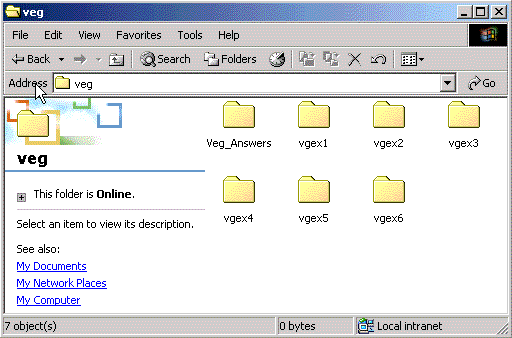
Global Land Vegetation Data for Use With
NASA Image2000
RETRIEVING DATA
Allows you to access the data for the tutorial and exercises
FOR FURTHER STUDY
Points you to sources of additional data related to this module
SATELLITE DATA INFORMATION
Gives information on the satellite instrument and the data used in this module
Before you begin retrieving data, be sure NASA Image2000 software is installed on your computer.
RETRIEVING DATA
Data for the exercises have been compressed into a single archive of Zip files. To extract the Zip archive using WinZip, click on the file called vgex_i2k.zip below. Follow WinZip's instructions for extracting an archive. When the download is complete and the archive is unpacked, you'll see the following folders and files inside a folder called veg.
Drag that folder into the "Data" folder in your Image2000 folder.
NOTE: In order to be able to follow the step-by-step instructions given in the exercises, be certain to extract the data files into the correct navigational path, as follows:
<i2k installed>|data|SEES|veg|<exercise number>|<file name>
The folder entitled "Veg_Answers" is empty -- it was intended as a placeholder only. Answers to the questions in the exercises are contained in the Instructor's Guide.
FOR FURTHER STUDY
Pathfinder AVHRR Land Data are available for download at the following anonymous ftp site: ftp://daac.gsfc.nasa.gov/data/avhrr. To log onto this site, use "anonymous@" for the user name and your e-mail address for the password. On this ftp site you will find the Global 1° and continental 8 km data sets that were used in these exercises. Also on this site are 8km Global data sets (these are very large) and about 50 8km subset regions from around the world. The data sets are from 1981 through 1994.
SATELLITE DATA INFORMATION
Pathfinder AVHRR Land (PAL) Data
The following information was extracted from a larger document. An HTML version of the complete Pathfinder AVHRR Land Data document is available at http://daac.gsfc.nasa.gov/DATASET_DOCS/avhrr_dataset.html
For more current information regarding the DAAC AVHRR archives, visit http://daac.gsfc.nasa.gov/CAMPAIGN_DOCS/LAND_BIO/GLBDST_main.html
This data set, produced as part of the NOAA/NASA Pathfinder AVHRR Land (PAL) program, contains global and continental monthly and 10-day composites of channels 1, 2, 4 and 5, and the Normalized Difference Vegetation Index (NDVI) at 8 km and 1° resolution. The data, derived from the Advanced Very High Resolution Radiometers (AVHRR) on the "afternoon" NOAA operational meteorological satellites (NOAA-7, -9, -11), cover the period from 1982 to 1992. The Pathfinder Program produces long-term data sets processed in a consistent manner for global change research.
Data Characteristics
| PARAMETER |
DESCRIPTION |
UNITS |
DATA RANGE |
| NDVI |
Normalized Difference Vegetation Index derived from the visible and near-infrared channel reflectances (0.58 to 0.68 µm and 0.73 to 1.10 µm, respectively) |
Unitless |
-1 to +1 |
| Ch1 |
AVHRR Channel 1 Reflectance |
% |
0 to 100 |
| Ch2 |
AVHRR Channel 2 Reflectance |
% |
0 to 100 |
| Ch4 |
AVHRR Channel 4 Brightness Temperature |
Kelvin |
160 to 340 |
| Ch5 |
AVHRR Channel 5 Brightness Temperature |
Kelvin |
160 to 340 |
| elev |
Ancillary Elevation file |
Meters |
-15000 to 10000 |
| lsm |
Ancillary Land Sea Mask |
N/A |
0 to 1 |
| lat |
Ancillary Latitude file |
Degrees |
-90 to 90 |
| lon |
Ancillary Longitude file |
Degrees |
-180 to 180 |
Temporal Resolution: 10-day and monthly composites.
Spatial Coverage: Global and Continental
Spatial Resolution: 8 km x 8 km and 1° x 1°
Starting Points and Ending Points
| Area |
North Latitude
|
South Latitude
|
West Longitude
|
East Longitude
|
Global
Africa
Asia
Australia
Europe
North America
South America |
90.0
38.5
79.0
7.5
76.7
72.5
13.2
|
-90.0
-37.8
4.5
-48.0
23.4
9.0
-57.0
|
-180.0
-20.0
25.6
93.5
-13.0
-165.0
-83.0
|
180.0
61.3
143.7
179.5
60.5
60.0
-33.0
|
Data Source
These data were collected by the Advanced Very High Resolution Radiometer (AVHRR) flown on NOAA-series satellites.
Nominal orbit parameters for the NOAA-7, -9, and -11 are
Launch date: 6/23/81 (NOAA-7), 12/12/84 (NOAA-9), 9/24/88 (NOAA-11)
Orbit: Sun synchronous, near polar
Nominal altitude: 833 km
Inclination: 98.8 degrees
Orbital period: 102 minutes
Equatorial crossing times: 114.30 (NOAA-7), 14.20 (NOAA-9),
13.40 (NOAA-11) LST
Nodal Increment: 25.3°
The orbital period of about 102 minutes produces 14.1 orbits per day. Because the daily number of orbits is not an integer, the suborbital tracks do not repeat daily, although the local solar time of the satellite's passage is essentially unchanged for any latitude. The 110.8° cross-track scan equates to a swath of about 2700 km. This swath width is greater than the 25.3° separation between successive orbital tracks and provides overlapping coverage (side lap).
The spectral band widths and Instantaneous Field of View (IFOV) of the AVHRR instrument are given in the following table.
|
Channel
|
Wavelength (micrometer)
|
IFOV (milliradian)
|
1
2
3
4
5
|
0.58 - 0.68
0.73 - 1.10
3.55 - 3.93
10.3 - 11.3
11.5 - 12.5
|
1.39
1.41
1.51
1.41
1.30
|
Data Format
Compressed format: The Pathfinder data on the ftp site has been compressed using Gzip, which reduces the size of the named files using Lempel-Ziv coding.
Uncompressed format: The Pathfinder data are processed as 32-bit floating point numbers to maintain maximum accuracy. In generating the output data, each layer is scaled to an appropriate 8-bit (unsigned) or 16-bit (unsigned) interger value corresponding to the ranges shown in the table below. Consequently, to obtain the geophysical values from the scaled data value, offsets must be subtracted from the scaled data value and the result multiplied by the gain. Complete information on scaling and bit representations are provided in the table below.
|
Parm.
|
Bits
|
Offset
|
Gain
|
Bin. Min/Max
|
|
NDVI
|
8-bit unsigned
|
128
|
.008
|
3 - 253
|
|
Ch1
|
16-bit unsigned
|
10
|
.002
|
10 - 50010
|
|
Ch2
|
16-bit unsigned
|
10
|
.002
|
10 - 50010
|
|
Ch3
|
16-bit unsigned
|
-31990
|
.005
|
10 - 36010
|
|
Ch4
|
16-bit unsigned
|
-31990
|
.005
|
10 - 36010
|
|
elev
|
16-bit unsigned
|
-15010
|
1
|
10 - 25010
|
|
lat
|
16-bit unsigned
|
9010
|
.01
|
10 - 18010
|
|
lon
|
16-bit unsigned
|
18010
|
.01
|
10 - 36010
|
|
lsm
|
8-bit unsigned
|
0
|
1
|
0 - 2
|
File Size, File Dimension
| File Type |
File Size (bytes) uncompressed
|
Columns
|
Rows
|
| Global 1-degree NDVI |
64800
|
360
|
180
|
| Global 1-degree Channel |
129600
|
360
|
180
|
| Global 8-km NDVI |
10848672
|
5004
|
2168
|
| Global 8-km Channel |
21697344
|
5004
|
2168
|
| Africa NDVI |
1166000
|
1100
|
1060
|
| Africa Channel |
2332000
|
1100
|
1060
|
| Asia NDVI |
1320500
|
1390
|
950
|
| Asia Channel |
2641000
|
1390
|
950
|
| Australia NDVI |
831600
|
1080
|
770
|
| Australia Channel |
1663200
|
1080
|
770
|
| Europe NDVI |
522600
|
780
|
670
|
| Europe Channel |
1045200
|
780
|
670
|
| North America NDVI |
893800
|
1090
|
820
|
| North America Channel |
1787600
|
1090
|
820
|
| South America NDVI |
669300
|
690
|
970
|
| South America Channel |
1338600
|
690
|
970
|
The ancillary files elev, lat, and lon are the same size and dimension as the channel files and lsm is the same size and dimension as the NDVI file, for their respective coverages.
Headers, Trailers, and Delimiters: None.
Fill Values: 0 is Missing Data Over Land, 1 is Ocean, 2 is Goode's Interrupted Space.
Image Orientation: North to South
Map Projection: Goode Interrupted Homolosine Projection (global 1° data is not projected)
Data Validation
A few validation checks have been built into the Pathfinder data processing (Quality Control Flags). Automated quality checks are made for consistency in fields such as date and satellite or scan times. Geophysical values are checked to see that they are within a reasonable range. Certain anomalies may exist in the data set because of conditions inherent in the input data, for example, missing scan lines or orbits, incorrect or incomplete calibration coefficients, and many of these data are flagged with the Quality control indicator.
Errors in the Computation of Solar Zenith Angles (SZA) have been found in the PAL Data Set. This error in the SZA in the daily and composite data, varies systematically with time and geographical location. An analysis of SZA from the PAL data set showed that the errors are smaller in the recent data (e.g., 2° in the 1992 data) and larger in the earlier data (e.g., 7° in the 1982 data). Errors in the solar zenith angle layer affect channel 1 and 2 reflectances, NDVI, CLAVR flags and the relative azimuth angles. A memo has been written that discusses the impact of these errors on the PAL data set.
The memo is accessible at the following URL. http://daac.gsfc.nasa.gov/CAMPAIGN_DOCS/LAND_BIO/zenith_angle_memo.html
| Home | Stratospheric Ozone | Global Land Vegetation | Oceanography | Polar Sea Ice Processes |

